
Empowering Early Learners: The Journey of Enjoy English Content Creation
‘Enjoy English’: An innovative Ed tech project
How did we learn our mother tongue, our first language? Did we learn the ABCs of it and how to form words and then read, write and speak the language? Were we taught ten new words every day and asked to repeat them? Quite contrarily, we acquired it through constant exposure in a given environment. We heard others speaking in our home and neighbourhood; we started experimenting with the language ourselves. Mimicking was our first attempt at communication. When this is the natural way a language is acquired, why should the process for learning a second language be any different?
The idea of ‘Enjoy English’ stems from the same belief: that students need to have contextual and regular exposure to the oral language to help them recognise and acquire the language. Hence, the programme prioritises oral development through exposure to real experiences, before moving on to the script of the language, and insisting on grammatical correctness.
The vision of project ‘Enjoy English’ is to offer a solution to the problem of poor English literacy among early first generation learners of English who have little to no exposure to English in their immediate environment, through significant focus on oracy (listening-speaking skills). The programme aims to build all the 4 necessary language skills in children (listening, speaking, reading and writing) but with a greater emphasis on laying a strong oral and aural foundation.
A multifaceted approach to Oracy-Centric Curriculum
With the vision of the oracy-forward curriculum in mind, the team tried to include as many different components as possible that would provide the students exposure to the language. Exposure was given through animated videos with a storyline, rhymes, audio-visual inputs to introduce phonic sounds, short stories to expose them to the communicative form of the language and finally, this was enhanced with a range of games, quizzes and activities on tablets.
Unveiling the thought process: A behind-the-scenes glimpse into the content creation
Making it contextual:
A lot of animated videos can be found online, like ‘Dora the Explorer’ and ‘Sesame Street’. But the challenge in using something like that, in a government school classroom in Tamil Nadu, is that some depictions, characters, objects and accents may be utterly alien to the students. We wanted to ensure that our content was rooted in the child’s environment. So we decided to produce the animated videos, ensuring the characters and scenes were contextual and also had an element of surprise to make it more interesting.
It was also made such that the same characters got repeated week over week and the students became intensely familiar with the adventures of Chikku, Chinni, Lola the parrot and Lee the alien - the characters that carried the programme through.
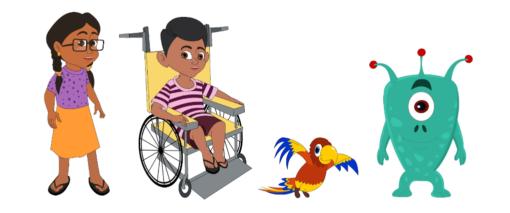
All the animated videos revolved around these 4 main characters: ‘Chinni’, ‘Chicku’, ‘Lola’ and ‘Lee’.
Not only were the animated videos contextual, but the images in the activities and other stories were also created to make the students feel like they were part of the story.
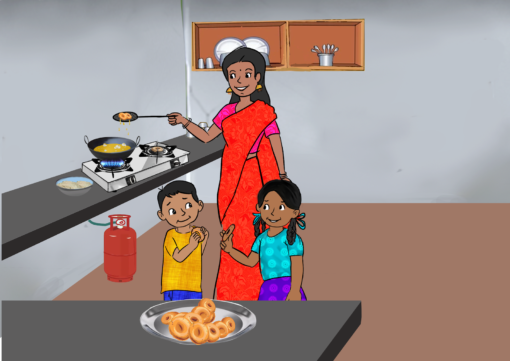
An image from a story where children are eating vada as an evening snack.
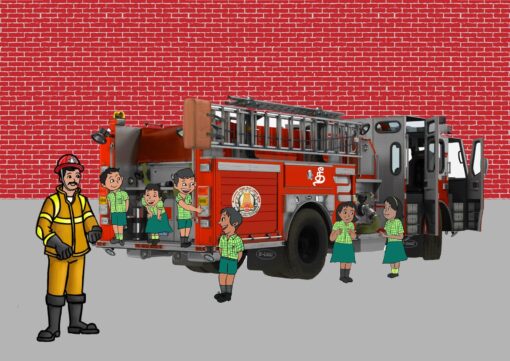
Since the project was piloted in government schools of Tamilnadu, the images were also made contextual by replicating the government school uniforms of the state.
Pathway to mastery:
We created the overall progression after observing well-known curricula worldwide and modifying them to fit our context. The themes for each week’s lessons followed the progression from ‘Knowing myself’ to ‘The world through my eyes’, then ‘My neighbourhood’, and finally ‘My Earth’. This progression was thought through such that there was a steady development in what the students learn, beginning from themselves, then their immediate surroundings and finally moving on to the larger world. The weekly vocabulary and sentence structures were also designed to follow the same progression. The sentences and actions the children would use daily, describing themselves, people and things in their neighbourhood, were introduced first, followed by sentences based on their experiences.
Even the sounds and letters introduced were based on a well-accepted phonic progression (slightly modified) starting with letters a, t, p and n, which ensured that they were first introduced to the sounds most common and those that could be made into words, rather than following the alphabetical order. On a similar note, we consciously ensured that any word introduced for learning was only based on already introduced sounds. For example, on a day when the sound of the letter ‘n’ was introduced, the words used would be - nap, pan, ant and so on instead of ‘nest’, which has ‘e’ and ‘s’, which hadn’t been introduced yet. This was to ensure that there was a steady shift from ‘known’ to ‘unknown’, an extremely effective way to lower children’s affective barriers.
Inclusivity:
The characters and scenes for every single content were thought out carefully to ensure equal representation across gender, religion, colour and disability. The main character of the animated video is in a wheelchair, and there are scenes which we have intentionally removed for stereotypes, to normalise different situations and actions.
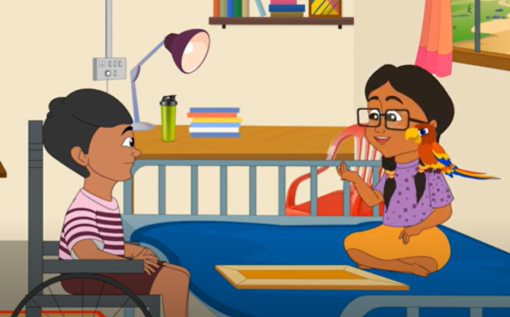
Chicku, Chinni and Lola the parrot playing a board game to meet their alien friend Lee.
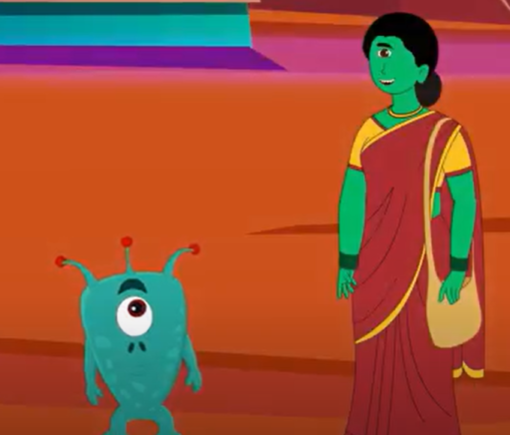
Lee the alien friend and an alien Postperson in alien land.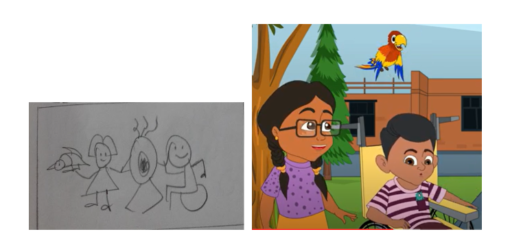
From inception of the characters on a storyboard to the final output
Accessibility:
All the content created needed to be accessible to students in all possible ways because if it weren’t, all the efforts wouldn’t reach the intended outcome. This was not just physical accessibility but more nuanced factors, like the number of words that would be the ideal length for the content’s intended audience. The sentence lengths and the total number of sentences and words for each story created were limited as the exposure to the English language would have been limited, and the intent was not to let students feel overwhelmed with large chunks of incomprehensible parts in the lesson.
We noticed that the animated videos played as part of the lessons, though engaging, did not reach its intended purpose. We realised that since the whole video was in English, the students could not follow it entirely and were frequently distracted. To tackle this challenge, we introduced bilingual videos summarising the stories and instructions for the activities to support students with comprehension. This improved the students’ interaction with the videos and encouraged them to follow the story keenly.
We further ensured that the activities aligned with the students’ skills pertaining to their development stage. There was a steady flow from known to unknown contexts so what they saw and learned in the classroom was not wholly alien but a balance of new contexts to aid learning.
And of course, fun and entertaining:
We kept the content simple and short so students could handle all the new information they received in a new language and made sure that each piece of content was engaging. We included a mix of games and actions throughout each section of the content to help students get a variety of activities to do in one class. Considering each piece’s engagement factor, it was always varied and explicitly designed. It also gave opportunities for students to practice dialogues and conversations.
A glimpse into the impact of the content:
At the end of the day, after all the care and effort put into each piece of content, it is worth it when we see students interact and engage with the content excitedly. The students could identify the characters and would look forward to the adventures of Chikku, Chinni, Lola and Lee. They loved being transported to the alien world and following along on the adventure while learning new words and sentence structures. Learning would happen so naturally that the students never felt stressed about these classes but looked forward to even the assessments on the tablets. While the focus was an oracy-forward curriculum, we still ensured that reading and writing skills were also introduced during the course to promote holistic language development among the students.
As a cherry on top, the data collected from a set of control groups and the group that was part of the Enjoy English treatment showed significant improvement in learning among all indicators, including Listening, Speaking, Reading and Writing. However, a combination of factors contributed towards these numbers; the way the content was designed; keeping the student as the central focus undoubtedly played a role in the improved performances.
Children in ‘Enjoy English’ classrooms performed more than 2x better in speaking and expression of the language as compared to their peers in the control group. This is a testament to the careful and thoughtful planning of the experiences to ensure every child is a fluent speaker of the language.
The graph below shows the % of improvement observed in students performance across the 4 learning indicators

Source: Enjoy English MEL Report
Though on first look the content for the classroom might seem like just a few different items each week, the thought and work that has gone behind each of it is a lot more than what meets the eye at first.
Link nội dung: https://myphamsakura.edu.vn/enjoy-english-a53871.html